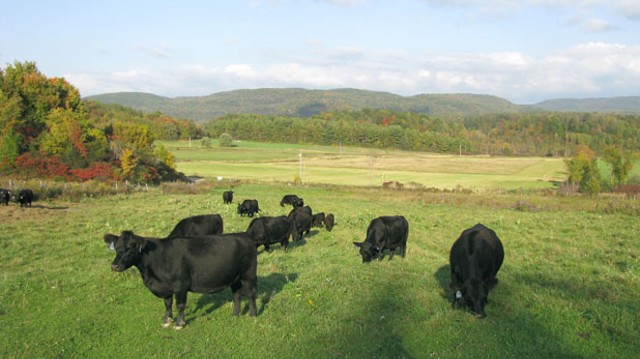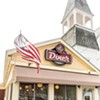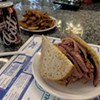Published March 20, 2013 at 11:42 a.m.
Paul List wears many hats. A career contractor, he’s owner of Liszt Historical Restoration, a company that trades on his expertise in antique building techniques to bring old buildings back up to snuff. In 1997, the classical violinist won raves for the album he produced of Beethoven’s Diabelli Variations. He maintains 1000 vines of Marquette grapes for Shelburne Vineyard around his Hinesburg home. But List is proudest of his role as the patriarch of a family of 150 Lowline Angus cattle.
Don’t believe it? Just watch as Ruby or Ina comes to List when he calls. “They’re like my dogs,” he says, rubbing one black cow’s ears. “I can tell who they are from their profile in the dark.”
List first brought Lowlines into his family six years ago as a hobby. Now he’s convinced that the smaller-than-average, hardy cattle that he raises at Grass Roots Farm are just what Vermont needs to build a healthy grass-fed-beef industry.
Developed as part of a long-term experiment in Australia, a Lowline Angus typically achieves a height of no more than 46 inches. But the small-boned animals put on fat and muscle like champs, which results in exceptionally high meat yields at slaughter. While most beef breeds have been engineered over the years to thrive on corn, Lowline Anguses get their might from nothing but grass and hay.
The Grass Roots herd is also uncommonly healthy, says List, who brags that his animals have never seen a needle. The cows receive no vaccinations, antibiotics, steroids or hormones. “I really think Vermont should be doing this,” List says of raising his beloved Lowlines. “I think this could really rejuvenate husbandry in the state. Commercial farming doesn’t do the industry any good.”
The farms that List considers “commercial” might surprise you — they include some prominent names in local beef. And renowned Vermont butcher and teacher Cole Ward agrees with List’s assessment. “Farmers farming ‘local’ in Vermont — a lot are doing a lot like the factory-farm industry is doing. It’s unfair to the consumer,” Ward says. “There are some that are selling a lot of beef as grass-fed, but it’s finished on corn and grain. Some are contracting to raise their animals in another state, then finishing them on Vermont farms.”
Ward is currently working on a book for Vermont’s Chelsea Green Publishing in which he’ll share his views on what constitutes quality local, sustainable meat. In the past five years, the butcher says, his opinion has seen a sea change: He used to consider grass-fed meat tough and low on flavor. Now he attributes that impression to the practices of many companies selling grass-fed meat that slaughter culled dairy cows not bred to thrive on grass alone.
Farms such as Grass Roots have changed Ward’s mind. Heritage breeds meant to grow fat on grass are producing meat that he compares in quality to the best Western beef. In addition to List’s product, Ward endorses North Hollow Farm in Rochester and Applecheek Farm in Hyde Park as producers of exemplary grass-fed beef. Both of these small farms include Devons, another breed that does well on grass, in their herds’ mix.
This reporter first tried Grass Roots’ beef at Hinesburgh Public House, where chef Shawn Beede compared the highly marbled meat to wagyu. “The short ribs or the osso bucco — man, holy crap, you almost want to eat it raw,” he said.
When I cooked a Grass Roots burger at home, I found the raw ground beef exceptionally silky to the touch. As my burgers grilled, they produced an uncommon amount of clear-running fat — just like wagyu. When eaten, the burger poured forth delicious, ungreasy juice. I wasn’t too concerned about the abundant fat, knowing it’s rich in Omega-3 fatty acid.
So why aren’t all of us meat eaters consuming delicious, grass-fed beef? There simply isn’t enough of it. Grass Roots Farm is currently able to slaughter just two animals a month. The meat from these animals goes to Hinesburgh Public House straight from the slaughterhouse, which is either Vermont Livestock Slaughter & Processing in Ferrisburgh or Royal Butcher in Randolph.
Before the Hinesburg restaurant opened last fall, List sold a pair of animals to Burlington’s Farmhouse Tap & Grill. “The two steer we bought were exceptional. They were right up there with the highest-quality 100-percent-grass-fed beef I’ve seen,” remembers chef Phillip Clayton. But List couldn’t keep up with the popular restaurant’s demands. “They’d eat this whole herd in six months,” he says.
But small scale is key to maintaining an excellent product, Ward says. “I don’t think, when you start raising a thousand or 2000 animals a year, you’re going to be able to keep those standards in place. Five hundred to 600, maybe 800 max, they can maintain that quality and integrity,” says the butcher, who recently helped draw up a cut chart to aid Hinesburgh Public House in maximizing the use of its Grass Roots beef.
List hopes one day to grow Grass Roots Farm to 400 or 500 head, with 80 to 100 animals born on his farm each year. To give himself room to expand, he’s in the process of adding a former dairy farm in Williston to the four Chittenden County patches that his cattle currently occupy. List doesn’t own any of the land that he aerates and tills himself, often working until midnight. He either leases it or arranges with the owners to occupy it in exchange for the current-use tax benefits and well-tilled fields they reap from the bargain.
While staying small is responsible, tiny Grass Roots Farm alone is unlikely to popularize Lowline Angus cattle the way List hopes to. That’s why he’s reaching out to other farmers, encouraging them to begin raising the animals. Among the younger farmers List has mentored are Rick King and Seth Brownell. King purchased his first two Lowlines in the summer of 2011 and raised them on his 20 acres of land in Swanton. Since then, the two have grown their herd to 16 animals. They plan to do their first slaughter this summer, keeping some of the meat for themselves and selling the rest from a freezer at Brownell’s home in Essex.
Brownell says they chose the Lowline Angus for its small size and puppyish temperament. The hobbyist farmer, who grew up on a dairy farm, only half jokes, “My experience wrestling with bigger cows wasn’t so much fun.”
List says he enjoys helping other farmers learn about his breed of choice. But he admits it’s not all charity: He needs more animals in the state to breed with his.
List’s evangelical zeal for Lowlines is matched by his near-obsessive work ethic. The recently divorced farmer admits that he lost his marriage to his cows. “Paul probably spends more time with his herd than he did with his wife,” notes Ward.
List says that neighbors and “the old boys’ club” of conventional farmers call him crazy. But he counters with, “I say, ‘If people don’t say you’re crazy, you’re too late.’”
List is convinced there’s a method to his madness, and in that method are the seeds of a rebirth of Vermont’s beef industry. The first step, he says, is to create a governing body to guarantee quality and true Vermont provenance. As Ward puts it, “Why is a beef cow that comes to Vermont at 10 months old and is fed genetically modified feed for four months allowed to be labeled ‘Vermont grass-fed’? For me, it’s about honesty and integrity … There’s so much deception.”
Ward and List envision a board or agency in which membership would require random farm inspections. State rules would govern where animals came from and what they ingested before slaughter. To qualify for the “Vermont grass-fed” label, a steer would need not only to have been born in the Green Mountains and not fed grain, but also to be free of antibiotics and hormones.
And what better breed to meet all those qualifications than the Lowline Angus? With droughts making production more difficult and costly out west, List thinks Vermont has a chance to make a name for itself in the beef world.
“I just really believe it’s time for Vermont to have the guts and the vision to start doing beef right,” he says. And for the rest of us to taste the difference.
The print version of this article was headlined "Paint It Black".
More By This Author
Speaking of Food, localvore Movement
-

Q&A: Howard Fisher Delivers Meals on Wheels With a Side of Good Cheer
Dec 20, 2023 -

Video: Howard Fisher Delivers Meals on Wheels
Dec 14, 2023 -

Q&A: Alexis Dexter Rescued 57 Shelter Cats During the July Flood
Sep 13, 2023 -

Video: Two Months After the Flood, Alexis Dexter Rebuilds Kitty Korner Café in Barre and Continues to Rescue Cats
Sep 7, 2023 -

Video: Saying Goodbye to Burlington’s Penny Cluse Café
Nov 17, 2022 - More »
Comments
Comments are closed.
From 2014-2020, Seven Days allowed readers to comment on all stories posted on our website. While we've appreciated the suggestions and insights, right now Seven Days is prioritizing our core mission — producing high-quality, responsible local journalism — over moderating online debates between readers.
To criticize, correct or praise our reporting, please send us a letter to the editor or send us a tip. We’ll check it out and report the results.
Online comments may return when we have better tech tools for managing them. Thanks for reading.















































